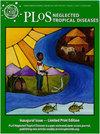Computer-aided discovery of novel SmDHODH inhibitors for schistosomiasis therapy: Ligand-based drug design, molecular docking, molecular dynamic simulations, drug-likeness, and ADMET studies
IF 3.4
2区 医学
Q1 Medicine
引用次数: 0
Abstract
Schistosomiasis, also known as bilharzia or snail fever, is a tropical parasitic disease resulting from flatworms of the Schistosoma genus. This often overlooked disease has significant impacts in affected regions, causing enduring morbidity, hindering child development, reducing productivity, and creating economic burdens. Praziquantel (PZQ) is currently the only treatment option for schistosomiasis. Given the potential rise of drug resistance and the limited treatment choices available, there is a need to develop more effective inhibitors for this neglected tropical disease (NTD). In view of this, quantitative structure-activity relationship studies (QSAR), molecular docking, molecular dynamics simulations, drug-likeness, and ADMET predictions were applied to 31 inhibitors of Schistosoma mansoni Dihydroorotate dehydrogenase (SmDHODH). The designed QSAR model demonstrated robust statistical parameters including an R计算机辅助发现用于血吸虫病治疗的新型 SmDHODH 抑制剂:基于配体的药物设计、分子对接、分子动力学模拟、药物相似性和 ADMET 研究
血吸虫病又称血吸虫病或蜗牛热,是一种由血吸虫属扁形虫引起的热带寄生虫病。这种经常被忽视的疾病对疫区造成了严重影响,导致长期发病,阻碍儿童发育,降低生产力,并造成经济负担。吡喹酮 (PZQ) 是目前治疗血吸虫病的唯一方法。鉴于耐药性的潜在增加和现有治疗选择的有限性,有必要针对这种被忽视的热带疾病开发更有效的抑制剂。有鉴于此,我们将定量结构-活性关系研究(QSAR)、分子对接、分子动力学模拟、药物相似性和 ADMET 预测应用于曼氏血吸虫二氢烟酸脱氢酶(SmDHODH)的 31 种抑制剂。设计的 QSAR 模型显示了稳健的统计参数,包括 R2 为 0.911、R2adj 为 0.890、Q2cv 为 0.686、R2pred 为 0.807 和 cR2p 为 0.825,证实了其稳健性。化合物 26 被确定为活性最高的衍生物,通过基于配体的药物设计,成为新的潜在抑制剂的候选先导化合物。随后,设计出了 12 个具有更强抑制活性和结合亲和力的新型化合物(26A-26L)。分子对接研究显示,所设计的化合物与目标受体之间存在着强烈而稳定的相互作用,包括氢键和疏水相互作用。100纳秒的分子动力学模拟和MM-PBSA自由结合能(ΔGbind)计算验证了两个最佳设计分子(26A和26L)的稳定性。此外,药物相似性和 ADMET 预测分析证实了这些设计化合物的潜力,表明它们有望成为治疗血吸虫病的创新药物。
本文章由计算机程序翻译,如有差异,请以英文原文为准。
求助全文
约1分钟内获得全文
求助全文
来源期刊

PLoS Neglected Tropical Diseases
Medicine-Infectious Diseases
CiteScore
7.40
自引率
10.50%
发文量
723
审稿时长
2-3 weeks
期刊介绍:
PLOS Neglected Tropical Diseases publishes research devoted to the pathology, epidemiology, prevention, treatment and control of the neglected tropical diseases (NTDs), as well as relevant public policy.
The NTDs are defined as a group of poverty-promoting chronic infectious diseases, which primarily occur in rural areas and poor urban areas of low-income and middle-income countries. Their impact on child health and development, pregnancy, and worker productivity, as well as their stigmatizing features limit economic stability.
All aspects of these diseases are considered, including:
Pathogenesis
Clinical features
Pharmacology and treatment
Diagnosis
Epidemiology
Vector biology
Vaccinology and prevention
Demographic, ecological and social determinants
Public health and policy aspects (including cost-effectiveness analyses).
 求助内容:
求助内容: 应助结果提醒方式:
应助结果提醒方式:


